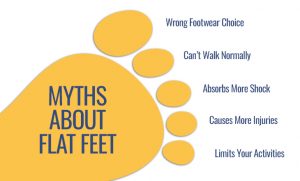
Understanding Flat Feet and Debunking Myths Around It

Imagine a footprint in the sand. For many of us, you’ll see an imprint of the heel, the toes, and a curve connecting them. Now, for some folks, that curve is more of a straight line, and voilà, you have a glimpse into the world of flat feet!
Flat feet, often dubbed as “fallen arches,” is a bit like a pancake foot. Instead of the middle part (or the arch) being raised, it’s closer to the ground. It’s as if the foot decided, “Why not hug the ground a bit more?” Babies are born champions of this flat-footedness, but as they grow, most develop that iconic arch by around age six. Yet, some decide to stick with their baby footprint style right into adulthood. And guess what? For many, it’s just another foot shape, like having curly or straight hair. However, for a select few, it might feel a bit like wearing shoes one size too small – a tad uncomfortable or even painful.

What are the Types of Flat Feet?
Buckle up, because the world of flat feet is more diverse than you might think:
- Flexible Flat Foot: Picture a foot that’s a part-time magician. Off the ground, it flaunts a sneaky arch. But the moment it steps down – poof – the arch vanishes! This magical foot transformation usually kicks off in childhood and can evolve with time. But why? Sometimes, the ropes and pulleys (or in medical lingo, tendons and ligaments) in the feet stretch or tear a bit.
- Rigid Flat Foot: No magic tricks here. These feet are all business, showing no arch whether they’re dancing in the air or stomping on the ground. It’s like having a foot that’s consistently in “flat mode,” which can sometimes feel a bit rigid or even sore.
- Adult-Acquired Flat Foot (or Fallen Arch): Imagine having a regular arch and then one day, it decides to take a vacation. That’s an adult-acquired flat foot for you! Often, this happens due to a moody tendon (the posterior tibial tendon) that supports the arch throwing a bit of a tantrum, either because it’s inflamed or has a small tear.
- Vertical Talus: Now, this one’s a rare gem. It’s a birth story where the talus bone in the ankle decides to march to its own beat, causing the foot to look like the bottom of a rocking chair. It’s like the foot is always ready to rock and roll!
To sprinkle in a bit more info, sometimes folks might have a Tight Achilles Tendon. It’s like having a guitar string that’s tuned too tight, causing a pinch when walking. Another noteworthy mention is the Posterior Tibial Tendon Dysfunction, a grown-up issue where the tendon (think of it as a sturdy rope) connecting the calf muscle to the inside of the ankle feels indisposed, either due to an injury or inflammation. This can lead to a foot singing the blues with pain in various areas.
Debunking Myths About Flat Feet
Flat feet, a condition where the arches of the feet flatten out, have been surrounded by numerous myths over the years. From the cause of flat feet to its implications and even the choice of footwear, there’s a lot of misinformation floating around. Let’s dive deep into these myths and uncover the truth.

- Flat Feet Occur Because of the Wrong Footwear Choice
Myth Debunked: Flat feet are primarily genetic in origin. They develop when the arch of the foot fails to form during childhood. However, it’s not always a hereditary condition. In some cases, flat feet can arise due to injuries to tendons or wear and tear associated with aging. While footwear can influence foot health in various ways, it is not the primary cause of flat feet.
2. Flat Feet Are Bad and I Will Never Walk Normally
Myth Debunked: Flat feet are more common than one might think. According to the 2012 National Foot Health Assessment, approximately 8% of U.S. adults, which equates to about 18 million people, have flat feet. Many individuals with flat feet live their entire lives without experiencing any significant issues, especially those with a flexible flat foot deformity. Those with a rigid flat foot deformity might experience some discomfort, but this can often be managed effectively. Furthermore, experts have suggested that feet with high arches might be more injury-prone due to their rigidity and limited shock absorption capabilities. In contrast, flat feet are generally more flexible and can handle the stress of activities like running and jumping better. It is essential, however, for individuals to seek medical attention if they experience pain.
3. Feet with High Arches Absorb More Shock
Myth Debunked: Contrary to popular belief, high-arched feet might not be the best at shock absorption. As Dr. Coughlin an orthopedic mentioned, from a biomechanical standpoint, high-arched feet can lack shock resistance and might even be unstable, especially during athletic activities. If given a choice, many would prefer flat feet for athletic endeavors due to their flexibility and shock absorption capacity.
4. People with Flat Feet Should Limit Their Activities
Myth Debunked: This myth couldn’t be further from the truth. Most orthopedists today believe that individuals with flat feet should not restrict their activities. Only a fraction of flat feet cases result in problems, and it’s challenging to predict which ones might be troublesome. As a general rule, those with flat feet should continue with their regular activities and seek medical advice only if they experience discomfort or pain.
5. People with flat feet have tendencies to cause more injuries:
Myth Debunked: Research has shown that having flat feet does not necessarily hinder running or athletic performance. A study published in the journal “Sports Medicine” in 2017 concluded that there’s no solid evidence linking foot type, such as flat feet, to running injuries. This means that having flat feet does not make someone more susceptible to injuries when running, and by extension, does not inherently hinder their running ability.
Conclusion:
Flat feet is just one of the many unique characteristics that make us human. While it may come with its set of challenges, especially for runners, it’s by no means a showstopper. With awareness and proactive measures, flat-footed runners can stride with confidence, comfort, and speed. Whether you’re a casual jogger or a marathon enthusiast, understanding and catering to your foot’s needs will ensure that every step you take is a step towards better foot health. Happy running!
References:
- Adam Hotchkiss, Adam Felman (2023): Want to Know About Flat Feet: MEDICALNEWSTODAY
- Flat Feet: Myths vs Reality: Urban Asian
- Dr. Thomas Crompton: Falling flat?Misconceptions about flat feet(2021): topdoctors.co.uk
- Flat-Out Myths About Flat Feet: RUNFOREVERSPORTS
- Elisabeth Rosenthal: The Maligned Flat Foot: The New York Times
- Flat Foot in Random Population and its impact on Quality of life and functionality: National Library of Medicine (https://www.ncbi.nlm.nih.gov/pmc/articles/PMC5449819/ )
- Flat Feet: NHS (https://www.nhs.uk/conditions/flat-feet/ )














